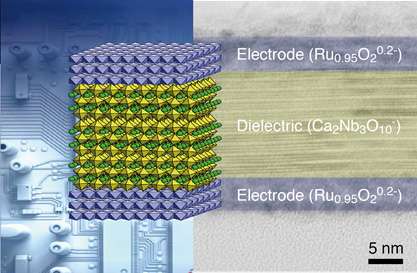Oxide nanosheets trump current state-of-the art capacitor materials

Electronics are getting smaller all the time, but there's a limit to how tiny they can get with today's materials. Takayoshi Sasaki and co-workers at the International Center for Materials Nanoarchitectonics, National Institute for Materials Science and Shinshu University in Japan have now developed a way to shrink capacitors, key components that store energy, even further, which could accelerate the development of more compact, high-performance next-generation devices.
Many recent improvements have already downsized capacitors significantly. But current technology has almost reached its limit in terms of materials and processing, which in turn limits the performance that manufacturers can achieve. In response, the researchers have gone to the nanoscale, but "nanocapacitors" are not easy to make.
Sasaki's team developed a LEGO-like approach, and they applied it to make high-performance ultrathin capacitors. They used conductive Ru0.95O20.2- and dielectric Ca2Nb3O10- nanosheets as core device components. By using solution-based assembly, they created a sandwich consisting of layers of two different types of oxide nanosheets to produce an ultrathin capacitor. The new capacitor has a stable capacitance density (~27.5μF cm-2), which is 2,000 times higher than that of currently available commercial products.
They see a number of possible extensions to the current work and conclude, "The virtually infinite varieties of oxide nanosheets, which can be used to assemble various nanosheet architectures, suggest that 2D heterointerfaces will offer an unprecedented versatility for the realization of new 2D states and molecularly thin film devices even beyond graphene."
More information: "All-nanosheet ultrathin capacitors assembled layer-by-layer via solution-based processes." Chengxiang Wang, et al. ACS Nano, 2014; 140219070102009 DOI: 10.1021/nn406367p
Journal information: ACS Nano
Provided by National Institute for Materials Science



















